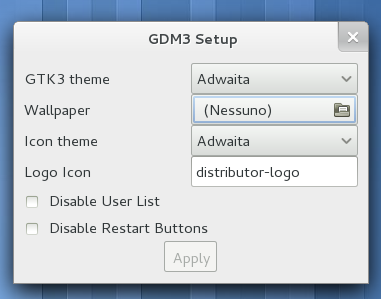How To Install Gdm3setup Ubuntu

I installed gdm3setup and gdm3setup-utilities. Ac3d Keygen Torrent. However I have no idea what logo or banner is, how to find suitable graphic? I saw lot of gdm themes on gnome-look page but they are ugly each one of them. Are those themes the same as banners or logos or something different? Videos on the topic are very, very old, some gdm themes on AUR try to install gdm-old or something like that.
Ulisse Joyce Pdf Italic Font here. In a nutshell, styling GDM is a confusing topic and no one covered it well. Default manjaro gnome GDM is ugly and boring (blackisch texture and buttons). I hope that someone will clear mystery of gdm3setup and that will allow me for some amount of customization.
At the moment I only changed icons and cursor, but the ugly background and login boxes remain. Michaldybczak: What DMs are the best for customizing then? Then one from plasma needs plasma to set it up so when having only gnome that's not a good idea. LightDM or maybe the one from mint? What do you recommend for gnome? You want use Wayland?
I installed gdm3setup and gdm3setup-utilities. Videos on the topic are very, very old, some gdm themes on AUR try to install gdm-old or something like that. I saw this ugly GDM in different distros but since manjaro gnome comes with the already customized desktop (ubuntu will be sooooo bold and. Change the GDM3 GNOME Shell / GTK theme; Change icon theme, wallpaper, cursor theme; Enable/disable automatic login; GNOME Shell: change logo, show date in clock, show. GDM3Setup is available for Ubuntu, Debian, openSUS, Fedora and Arch Linux and can be downloaded from GitHub.
At the moment GDM is the only safe way to run it. LightDM not support at the moment wayland. I don't know SSDM. In our repo exist a lot of greeters for LightDM ( i have also ported a modified version of the webkit2 greeter from Antergos ). Ste74: Depends.
You want use Wayland? At the moment GDM is the only safe way to run it Yeah, gnome usually runs on wayland and see no reason to change it. I'm not sure if I understand the whole thing within DM. Is DM itself running in wayland? I thought it only starts X or wayland sessions, maybe uses X itself.
When I was trying gdm3setup, there was a box to use wayland but it was unchecked, but if it wasn't working, then I'm not sure if the indication was correct. Can DM run itself as in X or wayland sessions? Does it really matter? Or maybe it's not about DM itself but does it can correctly start wayland session? Never thought about it before and never heard anyone talking about it. I saw this ugly GDM in different distros but since manjaro gnome comes with the already customized desktop (ubuntu will be sooooo bold and uninteresting now, there are other distros who have interesting, personalized gnome desktop). It could be ok for kali linux, it's not a normal daily desktop, but for manjaro?
I expected to see some kind of DM modifications and was very disappointed to see none, so I started to search how to change it myself and so far it seems hopeless. I need some gui, because all those details on arch wiki are confusing. I just don't know any of that stuff and it's too much. I don't know what you are looking for in terms of customizing. There are 3 apps for customizing gnome and gdm; gnome settings which list a variety of things you can customize. Then there is gnome tweak which allows you to enable themes that are installed. You'll have to look through it.
And dconf editor.BE CAREFUL USING DCONF EDITOR. To customize the gnome panel (at top) you will have to install gnome-shell-extensions. After you install them, you can open gnome tweak to enable them and set preferences for how they work. If you open 'add/remove software', type in 'gnome-shell-extensions. A bunch of results will show up.just read through them and find out what they are and what they do.there are quite a few of them.
There are two ways to do this. 1: Download the files and double-click them in your file manager. This should open the Ubuntu Software Center, where you can install them. The quicker way (2:) Download the files and install a program called gdebi. Sudo apt-get install gdebi. Gdebi will handle dependencies for you. Then, run gdebi on the files from the terminal with sudo gdebi./FILE.
You could also try your luck with just using sudo dpkg -i./File, but that won't automatically resolve dependencies for you.